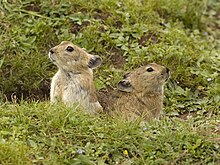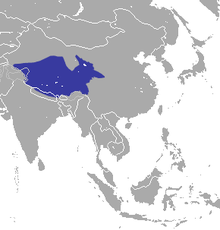Plateau pika
| Plateau pika | |
|---|---|
 | |
Conservation status | |
| Scientific classification | |
| Domain: | Eukaryota |
| Kingdom: | Animalia |
| Phylum: | Chordata |
| Class: | Mammalia |
| Order: | Lagomorpha |
| Family: | Ochotonidae |
| Genus: | Ochotona |
| Species: | O. curzoniae |
| Binomial name | |
| Ochotona curzoniae (Hodgson, 1858) | |
 | |
| Plateau pika range | |
The plateau pika (Ochotona curzoniae), also known as the black-lipped pika, is a species of mammal in the pika family, Ochotonidae.
It is a small diurnal and non-hibernating mammal weighing about 140 g (4.9 oz) when fully grown. The animals are reddish tan on the top-side with more of a whitish yellow on their under-belly.
They prefer to live in elevations of 3,100 to 5,000 m (10,200 to 16,400 ft), mostly in the Tibetan Plateau, which is where the common name originates from. The species is found in China, India, and Nepal in high alpine deserts, steppe and meadows, as well as tropical and subtropical montane forests.[1]
Role in the ecosystem
Plateau pikas are considered to be a keystone species as they play a role in recycling nutrients in soil, providing food to predators such as; foxes, weasels, falcons, Asia pole cat, upland buzzard, and owls. They also provide microhabitats by increasing plant richness and their burrows provides nests for small birds and reptiles.
According to the Chinese biologists who have studied the wildlife of the Hoh Xil (northern part of the Tibetan Plateau), plateau pikas are the favorite food of the area's brown bears.[2] In addition to its role as a prey base, the plateau pika is important for soil health in meadows; the burrowing of the species helps to aerate the soil. The species is currently considered threatened, mostly due to aggressive poisoning campaigns by Chinese populations, predominantly to eliminate competition for food with livestock.[1]
Mating
Plateau pikas have mating systems such as monogamous and polygynandrous groups, which contain about three males and 3 to 4 females per family along with their offspring. Females can produce 2 to 5 litters of about 2 to 7 offspring with a three-week interval in between each litter which is why this group of lagomorphs are known to have the fastest growth rates of their order. Their breeding season lasts from April to August and the young do not disperse in the year of birth. Males form hierarchies and females are usually philopatric forming reproductive alliances, helping each other in the care of their offspring, males also contribute in parental care when deterring a predator by emitting an alarm call. Pikas are social animals that live in families of two to five adults and their offspring.[1] Males and females both contribute in protecting their family groups from intruders displaying aggressive behaviors towards others who are not part of their family.[3]
Adaptations
Since plateau pikas live in such extremely cold environments and are a non-hibernating species, they have acquired physiological adaptations to better assist with their survival. These adaptations include their high resting metabolic rate and non- shivering thermogenesis along with the production of leptin which is a thermogenesis regulatory hormone.
Unlike hibernating mammals, plateau pikas do not merely rely on excess body fat to combat extremely cold climates. One important physiological adaptation is their ability to alter the type of their adipose tissue, from white to brown, which promotes non-shivering thermogenesis.[4]
Conservation and management


The plateau pika is considered a keystone species[5] and also considered a pest because of the degradation it causes to crops. This causes a competition in foraging[6] with the livestock of farmers such as yaks, sheep, and horses, which in turn affects their livelihood. Conservation efforts for the Plateau pika have focused on a number of strategies. One approach has been to raise awareness among local communities about the important role that the pika plays in the ecosystem and to promote more sustainable farming practices that do not rely on exterminating the animals.[7] This can involve providing alternative methods for protecting crops, such as using fencing or other physical barriers.
Another strategy has been to establish protected areas where the pika and other wildlife can thrive without interference from human activities. For example, the Sanjiangyuan National Nature Reserve in China,[8] which encompasses much of the Tibetan Plateau, has been designated as a protected area for the pika and other endangered species.
Finally, some researchers have been studying the biology and behavior of the Plateau pika in order to better understand the species and its role in the ecosystem. This information can then be used to inform conservation efforts and management strategies.
Overall, conservation efforts for the Plateau pika are aimed at ensuring the long-term survival of the species while also promoting sustainable development in the region.[9] By working to protect this important component of the high-altitude ecosystem, conservationists hope to maintain the ecological integrity and biodiversity of the region for generations to come.
References
- ^ a b c d Smith, A.T.; Liu, S. (2019) [amended version of 2016 assessment]. "Ochotona curzoniae". IUCN Red List of Threatened Species. 2019: e.T41258A160699229. doi:10.2305/IUCN.UK.2019-3.RLTS.T41258A160699229.en.
- ^ Xu Aichun, Jiang Zhigang, Li Chunwang, Guo Jixun, Wu Guosheng, Cai Ping, "Summer Food Habits of Brown Bears in Kekexili Nature Reserve, Qinghai: Tibetan Plateau, China". Ursus, Vol. 17, No. 2 (2006), pp. 132–137
- ^ Smith, A. T., Gao, W. X. (1991). "Social Relationships of Adult Black-Lipped Pikas (Ochotona curzoniae)". Journal of Mammalogy. 72 (2). [American Society of Mammalogists, Oxford University Press]: 231–247. doi:10.2307/1382094. ISSN 0022-2372. JSTOR 1382094.
- ^ Li, Jia; et al. (June 2018). "Chronic cold exposure results in subcutaneous adipose tissue browning and altered global metabolism in Qinghai-Tibetan plateau pika (Ochotona curzionae)". Biochemical and Biophysical Research Communications. 500 (2): 117–123. doi:10.1016/j.bbrc.2018.03.147. PMID 29626477. S2CID 4874398.
- ^ Smith, Andrew T.; Foggin, J. Marc (November 1999). "The plateau pika (Ochotona curzoniae) is a keystone species for biodiversity on the Tibetan plateau". Animal Conservation Forum. 2 (4): 235–240. doi:10.1111/j.1469-1795.1999.tb00069.x. ISSN 1469-1795. S2CID 7142483.
- ^ Pech, Roger P.; Arthur, Anthony D.; Yanming, Zhang; Hui, Lin (2007-03-05). "Population dynamics and responses to management of plateau pikas Ochotona curzoniae: Population dynamics and management of plateau pikas". Journal of Applied Ecology. 44 (3): 615–624. doi:10.1111/j.1365-2664.2007.01287.x.
- ^ Lambert, Joseph P.; Zhang, Xiaozheng; Shi, Kun; Riordan, Philip (January 2023). "The pikas of China: a review of current research priorities and challenges for conservation". Integrative Zoology. 18 (1): 110–128. doi:10.1111/1749-4877.12615. ISSN 1749-4877. PMID 34937133. S2CID 245440044.
- ^ Zhao, Xinquan; Xu, Tianwei; Ellis, Jacob; He, Fuquan; Hu, Linyong; Li, Qi (2020-12-16). "Rewilding the wildlife in Sangjiangyuan National Park, Qinghai-Tibetan Plateau". Ecosystem Health and Sustainability. 6 (1): 1776643. doi:10.1080/20964129.2020.1776643. ISSN 2096-4129. S2CID 225701702.
- ^ Davidson, Ana D; Detling, James K; Brown, James H (November 2012). "Ecological roles and conservation challenges of social, burrowing, herbivorous mammals in the world's grasslands". Frontiers in Ecology and the Environment. 10 (9): 477–486. doi:10.1890/110054. ISSN 1540-9295.
Further reading
- Jiapeng, Qu (2012). "Original Investigation: Life History Of The Plateau Pika (Ochotona Curzoniae) In Alpine Meadows Of The Tibetan Plateau". Mammalian Biology. 78: 68–72. doi:10.1016/j.mambio.2012.09.005.
- Zhao, Xin Quan (2011). "Functional Evolution Of Leptin Of Ochotona Curzoniae In Adaptive Thermogenesis Driven By Cold Environmental Stress". PLOS ONE. 6 (6): 1–11. Bibcode:2011PLoSO...619833Y. doi:10.1371/journal.pone.0019833. PMC 3116822. PMID 21698227.
- Zhang, Yanming (2009). "Original Investigation: Male Reproductive Success In Plateau Pikas (Ochotona Curzoniae): A Microsatellite Analysis". Mammalian Biology. 74 (5): 344–350. doi:10.1016/j.mambio.2008.10.001.
- Richard, Harris; Zhou, Jiake; Ji, Yinqiu; Zhang, Kai; Yang, Chunyan; Douglas, Yu (1 Dec 2014). "Evidence that the Tibetan fox is an obligate predator of the plateau pika: conservation implications". Journal of Mammalogy. 95 (6): 1207–1221. doi:10.1644/14-MAMM-A-021.
- BBC Nature - Plateau pika videos, news and facts
- ADW: Ochotona curzoniae: INFORMATION
- PlateauPika&Birds.pdf
- https://web.archive.org/web/20140224005514/http://aciar.gov.au/files/node/323/ecologically_based_rodent_management_part_11_53069.pdf
- Hogan_asu_0010E_10214.pdf
- Ochotona curzoniae - Plateau pika (Species)
- v
- t
- e
- Kingdom Animalia
- Phylum Chordata
- Class Mammalia
- Infraclass Eutheria
- Superorder Euarchontoglires
Family Ochotonidae (Pikas) | |||
|---|---|---|---|
| |||
| |||||||||||||||||||||||












